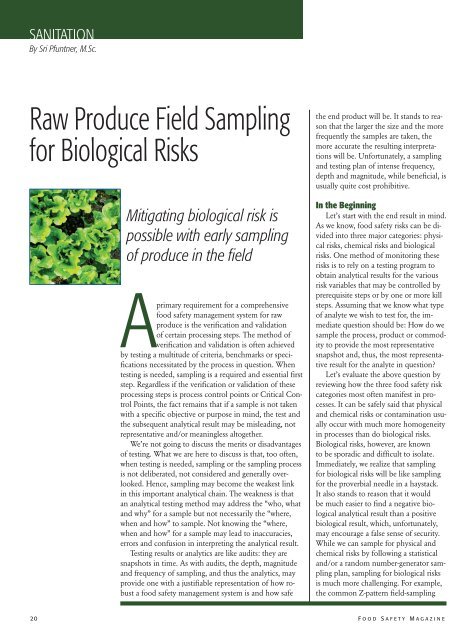Food Safety Magazine, February/March 2013
Food Safety Magazine, February/March 2013
Food Safety Magazine, February/March 2013
Create successful ePaper yourself
Turn your PDF publications into a flip-book with our unique Google optimized e-Paper software.
SANITATIONBy Sri Pfuntner, M.Sc.Raw Produce Field Samplingfor Biological RisksMitigating biological risk ispossible with early samplingof produce in the fieldAprimary requirement for a comprehensivefood safety management system for rawproduce is the verification and validationof certain processing steps. The method ofverification and validation is often achievedby testing a multitude of criteria, benchmarks or specificationsnecessitated by the process in question. Whentesting is needed, sampling is a required and essential firststep. Regardless if the verification or validation of theseprocessing steps is process control points or Critical ControlPoints, the fact remains that if a sample is not takenwith a specific objective or purpose in mind, the test andthe subsequent analytical result may be misleading, notrepresentative and/or meaningless altogether.We’re not going to discuss the merits or disadvantagesof testing. What we are here to discuss is that, too often,when testing is needed, sampling or the sampling processis not deliberated, not considered and generally overlooked.Hence, sampling may become the weakest linkin this important analytical chain. The weakness is thatan analytical testing method may address the “who, whatand why” for a sample but not necessarily the “where,when and how” to sample. Not knowing the “where,when and how” for a sample may lead to inaccuracies,errors and confusion in interpreting the analytical result.Testing results or analytics are like audits: they aresnapshots in time. As with audits, the depth, magnitudeand frequency of sampling, and thus the analytics, mayprovide one with a justifiable representation of how robusta food safety management system is and how safethe end product will be. It stands to reasonthat the larger the size and the morefrequently the samples are taken, themore accurate the resulting interpretationswill be. Unfortunately, a samplingand testing plan of intense frequency,depth and magnitude, while beneficial, isusually quite cost prohibitive.In the BeginningLet’s start with the end result in mind.As we know, food safety risks can be dividedinto three major categories: physicalrisks, chemical risks and biologicalrisks. One method of monitoring theserisks is to rely on a testing program toobtain analytical results for the variousrisk variables that may be controlled byprerequisite steps or by one or more killsteps. Assuming that we know what typeof analyte we wish to test for, the immediatequestion should be: How do wesample the process, product or commodityto provide the most representativesnapshot and, thus, the most representativeresult for the analyte in question?Let’s evaluate the above question byreviewing how the three food safety riskcategories most often manifest in processes.It can be safely said that physicaland chemical risks or contamination usuallyoccur with much more homogeneityin processes than do biological risks.Biological risks, however, are knownto be sporadic and difficult to isolate.Immediately, we realize that samplingfor biological risks will be like samplingfor the proverbial needle in a haystack.It also stands to reason that it wouldbe much easier to find a negative biologicalanalytical result than a positivebiological result, which, unfortunately,may encourage a false sense of security.While we can sample for physical andchemical risks by following a statisticaland/or a random number-generator samplingplan, sampling for biological risksis much more challenging. For example,the common Z-pattern field-sampling20 F o o d S a f e t y M a g a z i n e






![Otomatik indirilmez ise tıklayınız [Download]](https://img.yumpu.com/44170525/1/190x190/otomatik-indirilmez-ise-taklayanaz-download.jpg?quality=85)









